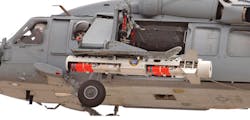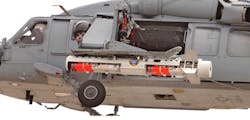Navy ramps-up production of unmanned airborne counter-mine systems
WASHINGTON - Naval Sea Systems Command officials in Washington are asking the Raytheon Integrated Defense Systems segment in Portsmouth, R.I., to build, test, and deliver low-rate initial production (LRIP) Airborne Mine Neutralization Systems (AMNS) and engineering services and support. Raytheon is doing the work under terms of an $11 million contract, which has options that could increase its value to as much as $58.1 million.
The AMNS will provide littoral combat ship (LCS) commanders with a rapid, organic mine neutralization capability against bottom and moored sea mines. The AMNS deploys explosive mine-destroying vehicles from a launch and handling system (LHS) on the Navy MH-60S helicopter as part of the LCS mine countermeasures mission module. The mine-destroying unmanned underwater vehicle (UUV) takes its control from the helicopter's common console; it identifies mines before controllers on the helicopter command it to explode and destroy the mine nearby.
The AN/ASQ-235 AMNS consists of two major subsystems: the LHS and the neutralizer. The LHS connects with the carriage stream tow and recovery system (CSTRS) and can carry as many as four neutralizers on each mission. Each of the four neutralizers can launch one at a time without recovering the LHS. The neutralizer communicates with the common console via a fiber-optic data link and provides sonar and video data to operators using the common console. The neutralizer contains a sonar, video camera, and light to find, identify, and attack enemy sea mines. Operators determine the neutralizer's position with an Integrated Track Point II acoustic tracking system in the LHS.
FOR MORE INFORMATION visit Ray-theon online at www.raytheon.com.

